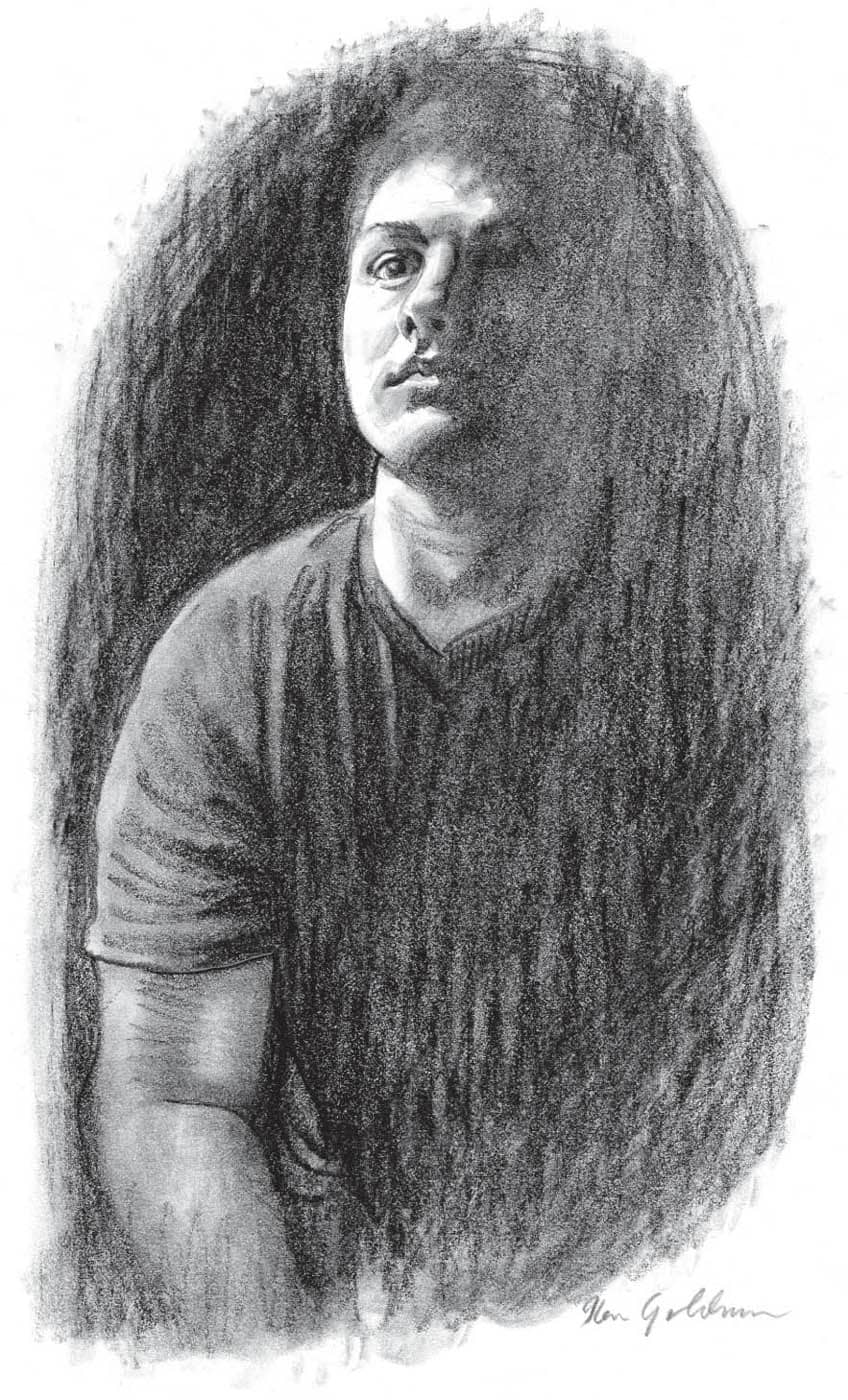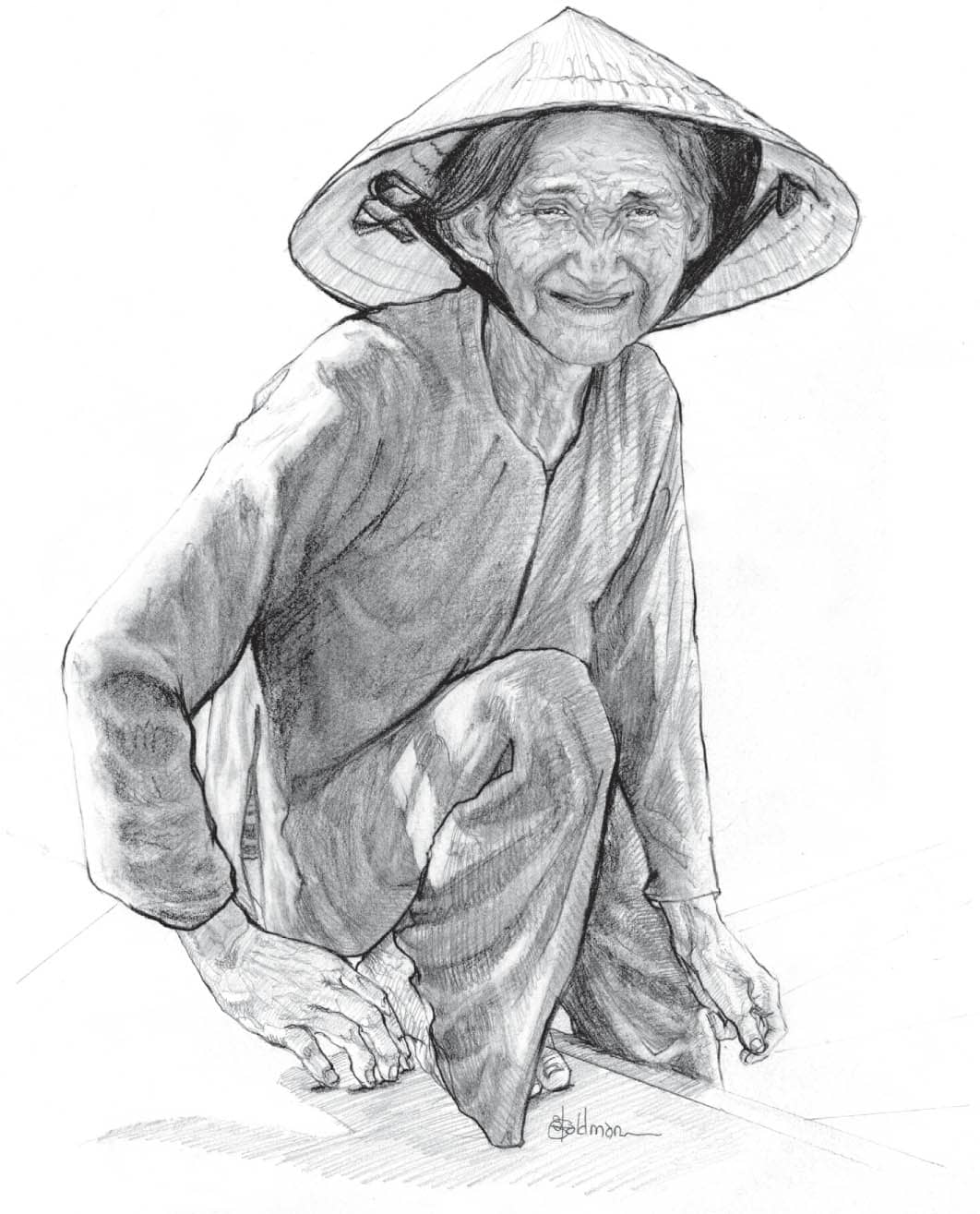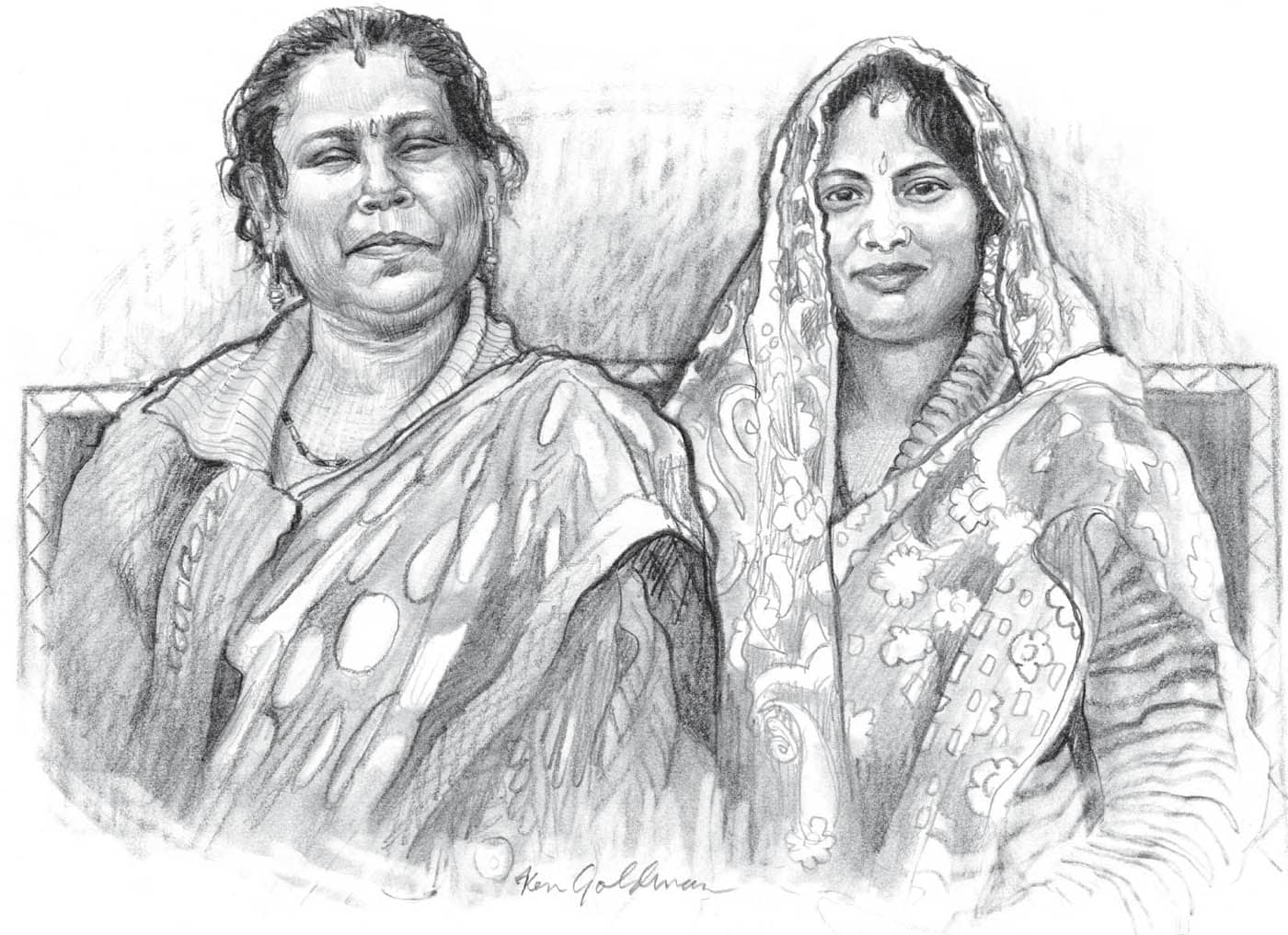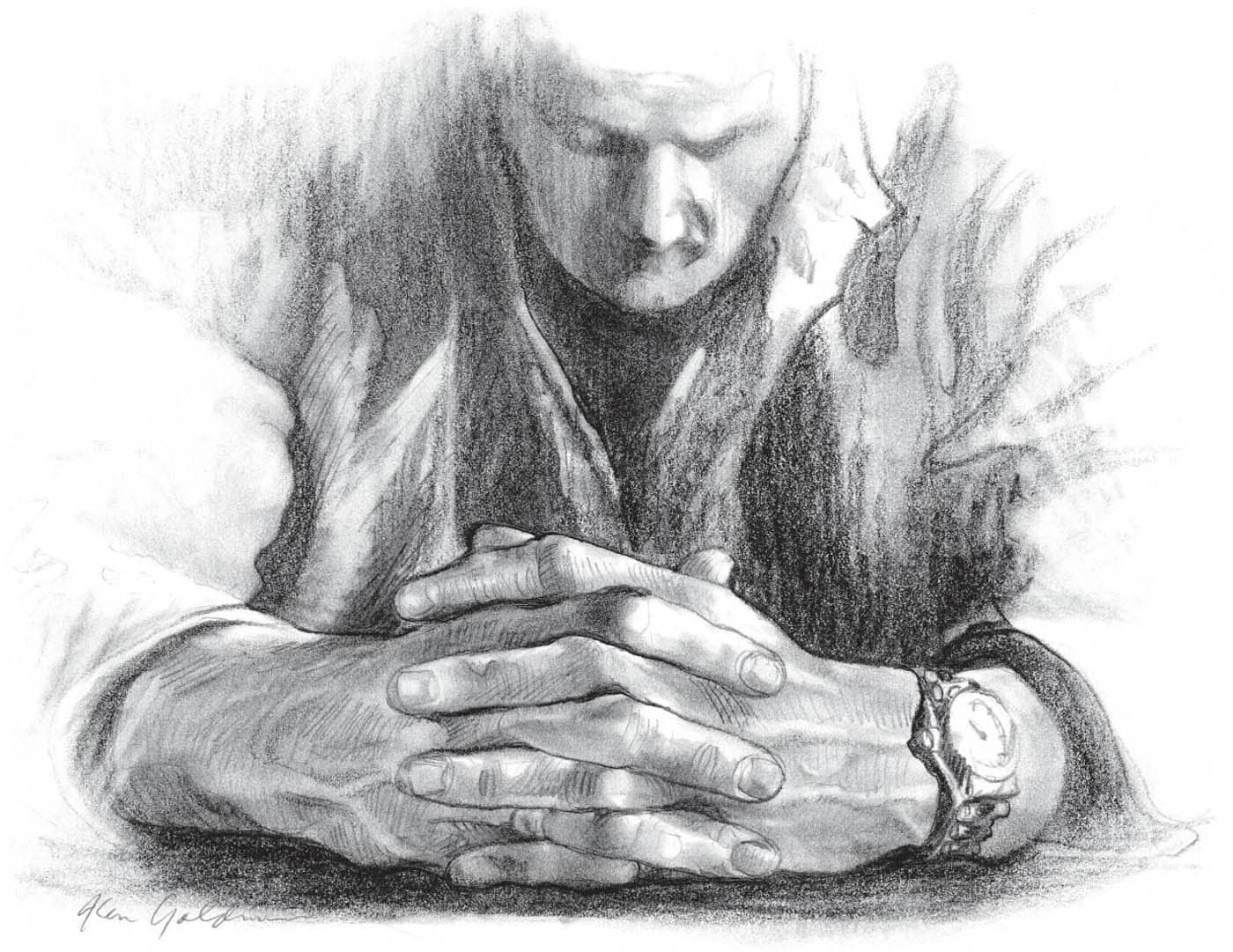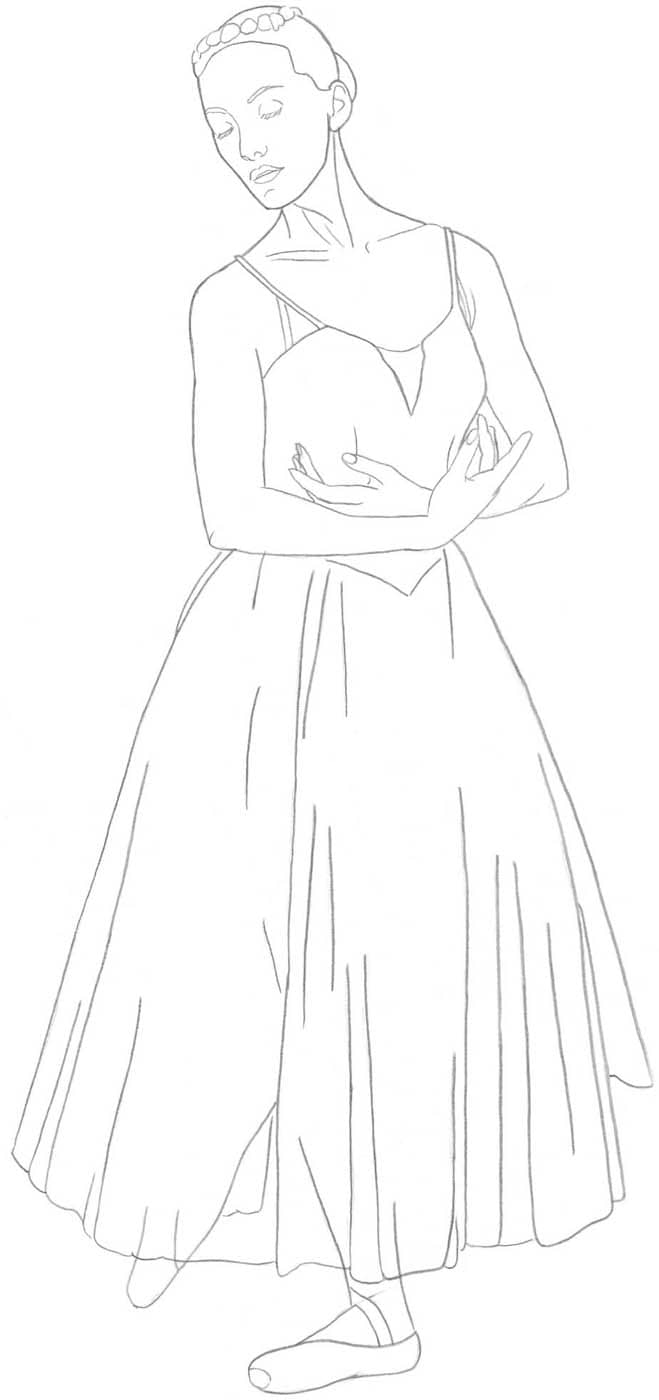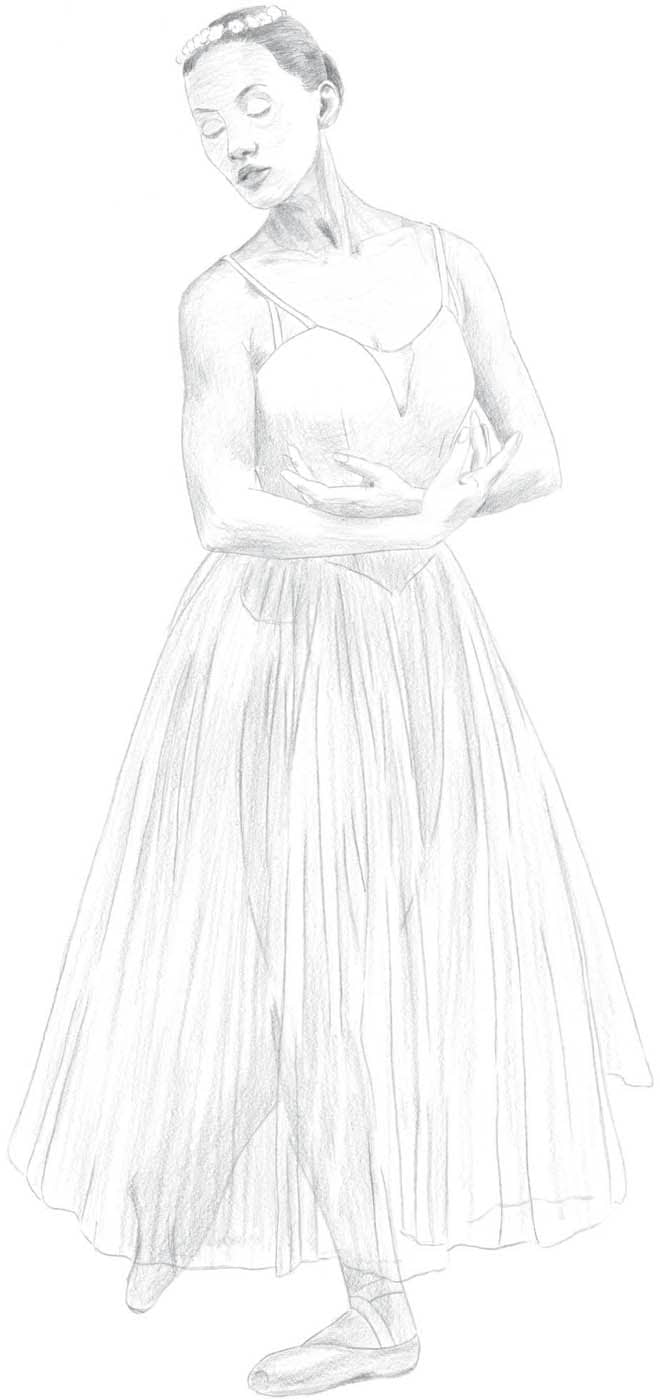Chapter 5
COMPOSITIONS
When drawing figures in graphite pencil in front of a landscape, keep the background light and simple so as not to detract from the subjects in the scene.
This mood of tender serenity is further enhanced by the use of light, horizontal background strokes in contrast to the vertical, more active foreground strokes.
This dynamic composition shows a form half enveloped in dark shadow with the light source coming from slightly above. The mood is serious and contemplative, making for a dramatic visual piece. Forms are most recognizable where hard edges meet. In portraiture, this is called a focal point. All other less important areas have soft or lost edges.
A low viewpoint with extreme foreshortening, as in this man’s hands, adds interest and drama to a composition. In this example, the man’s prayer beads dominate the overall design and suggest the significance of faith in his life. The focal point of this drawing—a mature hand holding beads—is rendered with great detail while all other areas are deliberately left vague.
To highlight the closeness of this mother and child, the figures are massed together. Notice how the diagonal line of the baby’s body mirrors the line of the mother’s arm, giving the composition flow.
Simple line work and a limited range of values give this scene the clarity and contrast needed to visually distinguish the two subjects.
Consider unconventional viewpoints for your portraits, which can capture a model’s sense of style or body language without even featuring the face.
“Backlighting,” also called “rim lighting,” occurs when the light source is positioned behind the subject. You can use this to create a silhouette-driven composition with soft shapes and an intimate, atmospheric quality.
When figures are lit from behind, all details are subordinated to a range of middle values. Leave the background bright and simple to keep the focus on your subjects in the foreground.
This woman is rendered with expressive lines that vary in thickness. The broken or “lost” lines that define the edge of the right arm indicate bright light coming from the upper left, inviting the sun—although not actually drawn—into the composition.
Two side-by-side figures centered on a bench make for a balanced composition with a sense of symmetry. In this drawing, overlapping the figures slightly creates a more unified mass, preventing any awkward negative space between the figures. Keep this in mind as you position your models. When incorporating patterned fabrics into a portrait, it’s best to avoid designs with high contrast and excessive detail. Keep the darkest tones and most intricate work on the heads, which serve as the clear focal points of the piece.
The weight and focal point lie near the bottom of this drawing, creating a stable, centered composition echoing the meditative seriousness of the figure. The wristwatch at right brings a bit of variation to the symmetrical scene. In addition to using 2B and 4B pencils for this rendering, a kneaded eraser and a blending stump help lift out highlights. The figure’s face is secondary to the focus— the folded hands.
This portrait of boys uses a traditional triangular (or pyramidal) composition, which creates stability while incorporating diagonal lines for interest. This compact arrangement also exudes a sense of emotional closeness between the boys.
The light and middle tones used to create this woman’s headscarf draw the viewer’s eye to areas of greater contrast, particularly the eyes. Her gesturing hand also brings interest to the composition.
This friendly man sits on the ground with his knees up, wrapping his arms so that his hands rest on his feet. This closed pose and simple composition is both reserved and intimate.
DANCER
1 First sketch the outlines of the figure. A simple, sleek, and airy composition perfectly suites this ballerina. The overall shape of her pose is an elongated triangle, which creates a sense of stability and balance. The long lines of her dress folds lengthen the appearance of her body to add flow and elegance.
2 Start establishing a base tone for the shadows and dark values by using the side of a 2B pencil to lay down a layer of tone in the hair. Then add dark tone to the eyebrows, lips, and nostrils. Using lighter pressure, add shading to the delicate shadow areas of the face, neck, and body. As always, use strokes that follow the form. Add some light tone to indicate the form of her legs, which can be partially seen through the transparent material. Then add some light tone to the dress using long, vertical strokes.
3 Return to the hair, stroking with the dull point of a 4B pencil in the direction of hair growth. Add more tone to the shadow side of the face using a 2B, noting that the light falls most directly on the side. Work around the body, adding more tone to areas where the forms turn away from the main light source. Add more shading to the upper part of the dress, again using strokes that follow the form of the body. Loosely add more long lines to indicate the folds of the dress.
4 Carefully shade her facial features with curved strokes that follow her form. Do the same around the neck area, shading the forms that indicate the underlying muscles of the neck. Continue to work around her arms and chest, and begin to shade her hands. As you work on her hands, remain aware of the small forms and shade delicately.
5 Return to working on her hair using the side of a 4B to achieve deeper tones, working softly around the hairline. Then use a sharp 2B to add a few lines for additional texture. Use the HB to delicately shade the flowers in her hair.
6 Focus on the folds of the dress and deepen the shading with long, vertical strokes. You don’t have to draw each fold exactly; instead, work loosely and quickly to suggest texture.
Sketch Every Day Sketching not only develops your hand-eye coordination, but it’s also a wonderful way to connect with the visual world around you. Carry your sketchbook around with you everywhere, and draw as many different types of subjects in as many different poses as possible. You will soon find yourself getting inspired and will have many ideas for drawings from your sketchbooks.
Sketch from Old Masters’ Work The Old Masters were thoroughly trained in their craft, and their drawings contain knowledge that can be absorbed when you copy them. It is great to do quick sketches of their work to get a sense of their compositions. And don’t be afraid to use one of their compositional ideas—great artists have copied compositions from other great artists for centuries!






